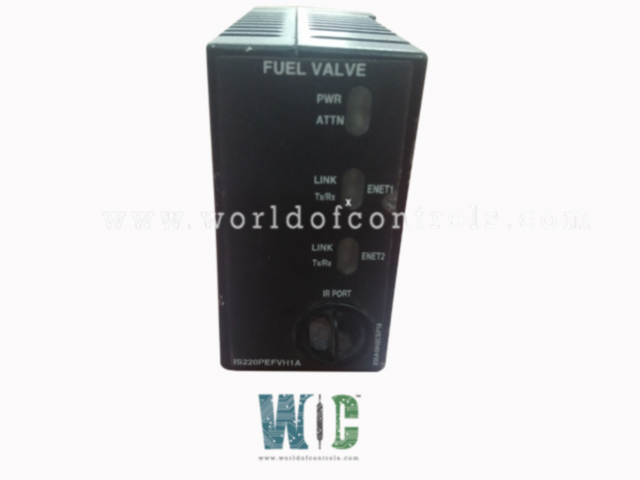
World Of Controls understands the criticality of your requirement and works towards reducing the lead time as much as possible.
IS220PEFVH1A - Electric Fuel Valve Gateway Module is available in stock which ships the same day.
IS220PEFVH1A - Electric Fuel Valve Gateway Module comes in UNUSED as well as REBUILT condition.
To avail our best deals for IS220PEFVH1A - Electric Fuel Valve Gateway Module, contact us and we will get back to you within 24 hours.
SPECIFICATIONS:
Part Number: IS220PEFVH1A
Manufacturer: General Electric
Series: Mark VIe
Product Type: Electric Fuel Valve Gateway Module
Transmit Time: 100 times /sec
Power supply voltage: 28 V dc
Fault Detection: Ethernet link ok to/from DVP
Voltage Range: 14 to 32 V dc
Outputs: 24 V dc
Mounting: DIN-rail mounting
Technology: Surface mount
Operating temperature: -30 to 65�C
Size: 8.26 cm high x 4.19 cm
Repair: 3-7 Day
Availability: In Stock
Weight: 2 lbs
Country of Origin: United States
Manual: GEH-6721G
FUNCTIONAL DESCRIPTION:
IS220PEFVH1A is an Electric Fuel Valve Gateway Module manufactured and designed by General Electric as part of the Mark VIe Series used in GE Distributed Control Systems. The Electric Fuel Valve Gateway (PEFV) is an Ethernet gateway between the Mark VIe I/O Ethernet network and an electric fuel valve interface module. The module communicates through the Ethernet Global Data (EGD). The fuel valve interface module is called a Digital Valve Positioner (DVP). It is made by Woodward Controls. The PEFV contains a processor board common to all Mark VIe I/O packs. One of the dual RJ45 Ethernet connectors connects to the I/O Ethernet network. The other RJ45 Ethernet connector connects directly to the DVP. A 3-pin connector supplies power to the pack.
COMPATIBILITY:
The Electric Fuel Valve Terminal board (TEFVH1A), in this configuration, is used to mount the PEFV only. The connections on the board are for electronic ID only. It uses no other connections. Visual diagnostics are provided through indicator LEDs on the PEFV. An infrared port provides local diagnostic serial communication. Control mode refers to the number of I/O packs used in a signal path:
INSTALLATION:
OPERATION:
The processor board connects to an acquisition board specific to the I/O pack function. Upon application of input power, the soft-start circuit ramps up the voltage available on the processor board. The local power supplies are sequenced, and the processor reset is removed. The processor completes self-test routines and then loads application code specific to the I/O pack type from flash memory. The application code reads board ID information to match the application code, acquisition board, and terminal board correctly. With a good match, the processor attempts to establish Ethernet communications, starting with the request of a network address. The address request uses the industry standard dynamic host configuration protocol (DHCP) and the unique identification read from the terminal board. After Ethernet initialization, the processor programs the on-board logic, run the application, and enables the acquisition board to begin operation.
WOC has the largest stock of GE Distributed control systems OEM replacement parts. We can also repair your faulty boards and supply unused and rebuilt boards backed up with a warranty. Our team of experts is available round the clock to support your OEM needs. Our team of experts at WOC is happy to assist you with any of your automation requirements. For pricing and availability on parts and repairs, kindly contact our team by phone or email.
What is an Electric Fuel Valve Gateway?
An Electric Fuel Valve Gateway is a device that manages and controls the flow of fuel in an electronic fuel system. It acts as an interface between the fuel supply and the engine, ensuring precise fuel delivery for optimal engine performance.
How does an Electric Fuel Valve Gateway work?
The gateway receives electronic signals from the engine control unit (ECU) to regulate the opening and closing of the fuel valve. This ensures that the correct amount of fuel is delivered to the engine based on its operational needs.
What are the Services that WOC offers?
WOC offers services such as Repairs, Tests with Certifications, Exchange schemes, Training, Field Service, Troubleshooting, Health Checks, HMI Upgrades, Refurbishment of Circuit Boards, Annual maintenance and Supply, Operating Support Systems, EPROM backups, and Warranties. Moreover, We have a buy-back facility for parts, ranging from minor parts to the entire control system panel. We have an in-house lab for repairs and testing facilities on site.